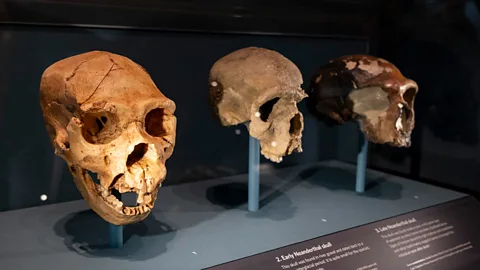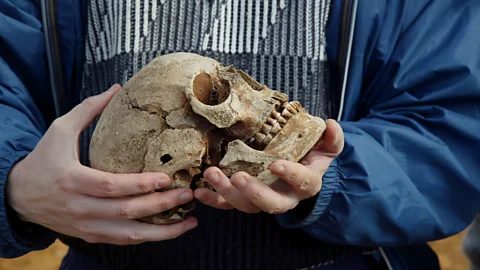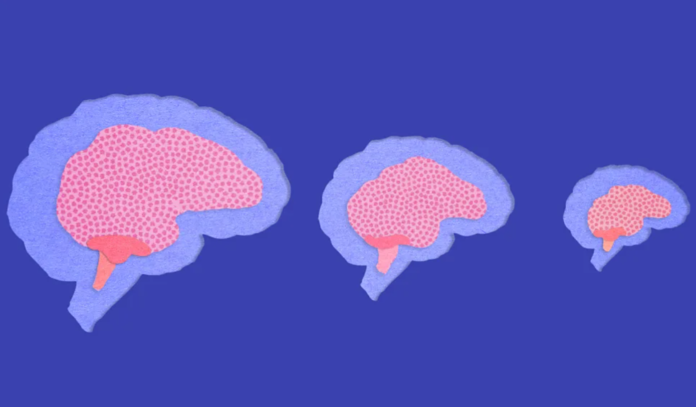The brains of modern humans are around 13% smaller than those of Homo sapiens who lived 100,000 years ago.Exactly why is still puzzling researchers.
Traditionally our “big brain” is thought to be what sets our species apart from other animals. Our capacity for thought and innovation allowed us to create the first art, invent the wheel, and even land on the Moon.
Certainly, when compared with other animals of a similar size, our brains are gigantic. The human brain has nearly quadrupled in size in the six million years since our species last shared a common ancestor with chimpanzees. However, studies show this trend toward larger brains has reversed in Homo sapiens. In our species, average brain sizes have shrunk over the course of the last 100,000 years.
For example in a recent 2023 study, Ian Tattersall, a paleoanthropologist and curator emeritus with the American Museum of Natural History in New York City, tracked the braincase volumes of ancient hominins through time. He started with the oldest known species, and ended with modern humans.
He found that rapid brain expansion occurred independently in different species of hominins, and at different times across Asia, Europe and Africa. Species whose brains grew over time include Australopithecus afarensis, Homo erectus, Homo heidelbergensis, and Homo neanderthalensis.

However, the trend for brain enlargement over time was turned on its head with the arrival of modern humans. The skulls of men and women today are on average 12.7% smaller than that of Homo sapiens who lived during the last ice age.
“We have very peculiarly shaped skulls, so early humans are very easy to recognise – and the very first ones have extremely large brains,” says Tattersall.
Tattersall’s finding replicates those of others. For example in 1934, Gerhardt Von Bonin, a German-born scientist affiliated with the University of Chicago at Illinois, wrote that “there is a definite indication of a decrease [in the human brain] at least in Europe within the last 10,000 or 20,000 years.”
So how can we explain this striking reduction? Tattersall suggests that the shrinkage in brain size began around 100,000 years ago, which corresponds to a period of time in which humans switched from a more intuitive style of thinking to what he terms “symbolic information processing” – or thinking in a more abstract way to better understand your surroundings.
As smaller and better organised brains were able to perform more complex computations, metabolically expensive larger brains simply became unnecessary
“This was the time when humans began producing symbolic artefacts and engravings with meaningful geometric images,” says Tattersall.
Tattersall believes that the catalyst that caused this change in thinking style was the spontaneous invention of language. This led to the neural pathways of the brain being reorganised in a more metabolically efficient way, allowing humans to get more “bang for their buck”.
In other words, as smaller and better organised brains were able to perform more complex computations, metabolically expensive larger brains simply became unnecessary.

“It seems to me that probably our predecessors processed information in a sort of a brute-force way, and intelligence in this context scaled with brain size. So, the bigger your brain, the more you got out of it,” says Tattersall.
“But our way of thinking is different. We deconstruct the world around us into a vocabulary of abstract symbols, and reassemble those symbols to ask questions like ‘What if?’
“This sort of symbolic thinking must have required a much more complex set of connections inside the brain than was present earlier. My suggestion is that having these extra connections allowed the brain to function in a much more energy-efficient way.”
However other palaeontologists argue that the fossil record shows that brains began shrinking more recently than Tattersall suggests, meaning the change couldn’t be linked to language. The date at which Tattersall puts language acquisition at (100,000 years ago) is also contested.
“I love this theory, I think it’s actually brilliant,” says cognitive scientist Jeff Morgan Stibel from the Natural History Museum in California.
Stibel believes that a changing climate, and not language, could explain our smaller brains
“But we haven’t seen the data to show that there was a decline as far back as 100,000 years ago that didn’t result at some point in a reversal where brain size began increasing again. There were declines back then. But then brain size started growing again, so the data doesn’t yet match that hypothesis.”
Stibel believes that a changing climate, and not language, could explain our smaller brains. In a 2023 study, he analysed the skulls of 298 Homo sapiens over the past 50,000 years. He found that human brains have been shrinking for about the last 17,000 years or so – since the end of the last ice age. When he carefully examined the climate record, he found that decreasing brain sizes correlated with periods of climate warming.
“What we saw was, the warmer the climate, the smaller the brain size in humans, and the cooler the climate, the bigger the brain,” says Stibel.
Smaller brains could have allowed humans to cool down quickly. It’s well known that humans in hot climates have evolved leaner and taller bodies to maximise heat loss. It’s possible that our brains could have evolved in a similar fashion.

“These days if get hot we can put on a T-shirt, jump in a pool, or turn on the air conditioning, but 15,000 years ago these options weren’t available to us,” says Stibel.
“The brain is the largest energy hog of all the organs, as it weighs about 2% of our body mass but consumes over 20% of our resting metabolic energy. So, if the brain is a huge consumer of energy and heat, then it should likely adapt to climate as well. Our theory is that smaller brains dissipate heat better, and have a reduced heat output too.”
The finding suggests that today’s rapidly warming planet could cause our brains to shrink even further.
The rise of complex civilisations
Perhaps the most prominent theory put forward to explain our shrinking brains is that it began when our ancestors stopped being hunter-gatherers, laid down roots, and began to build complex societies.
In 2021, Jeremy DeSilva, an anthropologist at Dartmouth College in the US, analysed cranial fossils ranging from Miocene hominid Rudapithecus (9.85 million years ago) to modern humans (300,000 to 100 years ago). He calculated that our brains started shrinking just 3,000 years ago, at around the same time that complex civilisations first began to emerge (although he has since revised his estimate, arguing that the decline in brain size happened between 20,000 and 5,000 years ago).
Nutrient deficiency could explain our contracting craniums
DeSilva suggests that the birth of complex societies and empires meant that knowledge and tasks could be spread out. People no longer had to know everything, and as individuals no longer had to think as much to survive, their brains reduced in size.
However, this theory too is contested.
“Not all hunter-gatherer societies became complex in the same type of way as, say, the Egyptians did 3,000 years ago, but brain sizes have reduced in these societies too,” says Eva Jablonka, professor emeritus at the Cohn Institute for the History of Philosophy of Science and Ideas at Tel Aviv University in Israel.
Jablonka argues that if even if brains did shrink when complex societies emerged, it doesn’t necessarily follow that smaller brains were necessarily an adaptive response.
“If 3,000 years ago much larger more complex societies emerged, this could correlate with much greater differences in social classes. If, as a consequence the majority of people were poor, then we know that poverty and malnutrition and things like that would compromise the developing brain.”

Marta Lahr, from Cambridge University’s Leverhulme Centre for Human Evolutionary Studies, has also suggested that nutrient deficiency could explain our contracting craniums. In 2013, she analysed bones and skulls from across Europe, Africa and Asia. She found that the largest-brained Homo sapiens lived 20,000 to 30,000 years ago, and that human brains started to shrink 10,000 years ago.
This is within the timeframe that our ancestors are thought to have stopped being hunter-gatherers and switched to agriculture. She argues that a reliance on farming may have created vitamin and mineral deficiencies, resulting in stunted growth.
Meanwhile some scientists have proposed that human skulls got smaller as a consequence of self-domestication, based on the fact that domesticated species like dogs and cats (which are bred for their friendliness) have brains that are 10-15% smaller than their wild ancestors. If friendlier, more social humans were more successful from an evolutionary perspective, then brains may have shrunk over time. But not all are convinced.
“I don’t buy the self-domestication theory,” says Jablonka.
When the decrease in size began is a question that is not entirely clear because the record isn’t that good – Ian Tattersall
“Self-domestication, if it occurred, must have happened something like 800,000 years ago, and there is no evidence whatsoever that human brains shrank at that time.”
So where does that leave us? Unfortunately, to understand why brains shrank, you would need to pinpoint exactly when the shrinkage began. But the fossil record makes this an almost impossible task. Older fossils are harder to find, so the record is heavily skewed towards newer specimens. For some poorly preserved species, we are currently dependent on a few or even a single cranium.
“What we do know is that back in the Pleistocene, human brains were about the same size as Neanderthal brains, which is quite a bit bigger than the average size of human brains today,” says Tattersall.
“The average of all Homo sapiens brains that are more than about 20,000 years old, is also high. But when the decrease in size began is a question that is not entirely clear because the record isn’t that good. All we know is that back then brains were large, and they’re about 13% smaller today.”
Are we becoming less smart?
If brains are shrinking, what does this mean for human intelligence? Depending on which theory you believe, smaller brains could either make us smarter, dumber, or have no effect whatsoever on intelligence.
It’s true that brain size isn’t everything. Men’s brains are around 11% larger than women’s brains due to their bigger body size. Yet research has shown that women and men have similar cognitive abilities. There is some contested evidence that smaller brained hominin species, such as Homo floresiensis and Homo naledi, were capable of complex behaviours, suggesting that how a brain is wired is the ultimate determinant of intelligence. However, in general, having a bigger brain relative to your body size does correlate with intelligence.
“The fact that our brain size is decreasing significantly right now yields the logical conclusion that our capacity for greater intelligence is either shrinking, or at least not growing,” says Stibel.
“However, what we have done over the last 10,000 years is created tools and technologies that allow us to offload cognition onto artefacts. We’re able to store information in computers, and use machines to calculate things for us. So our brains might be delivering less capacity for intelligence and brainpower, but that doesn’t mean that we as a species collectively are growing less smart.”
—

